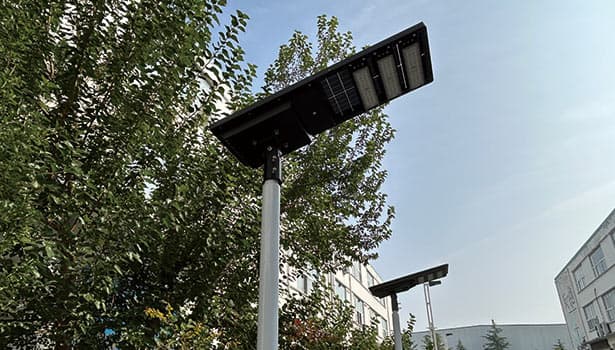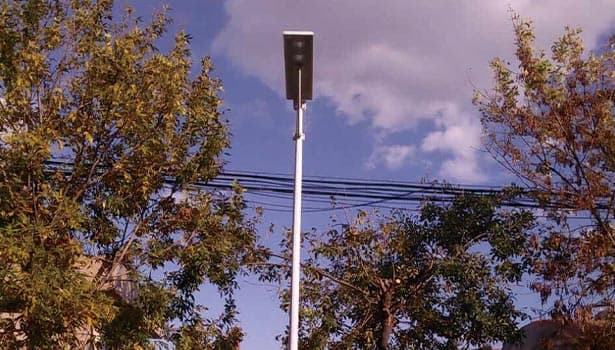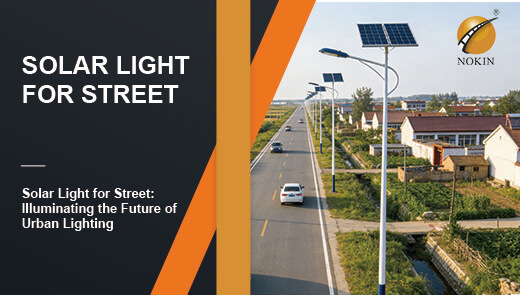Will Solar Street Lights Work In Shade?
In the planning of urban green areas, community green belts or park roads, people often raise the question: "Can solar street lights installed under the shade be used?"
The answer is clear: Solar street lights can work under the shade of trees, but their working efficiency will drop significantly. The specific manifestations are as follows: the solar panels absorb less sunlight, resulting in insufficient battery storage capacity. Eventually, the situation may occur where "the night lighting time is shortened (for example, what was originally lit for 8 hours is now only lit for 4 hours)" or "the light brightness dims (from 500 lumens to 200 lumens)".
It should be particularly noted that "partial shade" (such as sparse branches) can still allow the solar panels to capture a small amount of light, preventing them from being completely unable to generate electricity. However, from the perspective of long-term use and performance guarantee, an area without obstructions and that can receive direct sunlight is the best installation environment for solar street lights.

Why Do Shades Become An "Invisible Obstacle" for Solar Street Lights?
To understand the impact of tree shade on solar street lights, it is necessary to start from the core logic of solar power generation - the power generation of solar panels directly determines the battery's storage capacity, and the storage capacity directly affects the lighting effect and the lifespan of the equipment. The presence of tree shade can have negative impacts from three dimensions: power generation, lighting performance, and equipment lifespan.
The "source obstruction" of solar panel power generation
The power generation core of solar street lights is the solar panel, which operates based on the "photovoltaic effect" : when photons in sunlight strike silicon-based semiconductor materials, they excite electron transitions to form an electric current, converting light energy into electrical energy, which is then stored in lithium batteries.
The essence of tree shade is to reduce the number of photons reaching the surface of the solar panels through obstructions such as branches, leaves and tree trunks. For example:
Under the thick shade of trees, the amount of solar radiation received by solar panels may only be 30% to 50% of that in direct sunlight.
Even sparse tree shade can cause intermittent sunlight exposure, disrupting the continuity of power generation - just like intermittently cutting off power to solar panels, which cannot stably generate current.
The final result is that the battery's storage capacity drops significantly, laying a hidden danger for the subsequent decline in the lighting performance of solar street lights.
The lighting effect fails to meet the actual requirements
The night lighting of solar street lights relies entirely on the electrical energy stored in the battery during the day. When the shade of trees causes insufficient power storage, the lighting performance will directly "shrink". There are two common problems:
One is "insufficient lighting duration". For instance, the design standard of a certain solar street light is "to stay lit for 8 hours in direct sunlight (from 6 p.m. to 2 a.m.)". If it is installed under the shade of trees, the stored power may only be sufficient to support for 4 to 5 hours, and it will go out before the early hours of the morning, failing to meet the lighting needs throughout the night. This would directly affect the safety of pedestrians in scenarios such as community roads and park walkways.
The second is "reduced brightness". Some solar street lights extend the lighting time by "automatically reducing power" : when the battery power is detected to be insufficient, the brightness will be reduced from the rated 600 lumens to 300 lumens or even lower. This "dim light" state not only fails to meet the brightness standards for road lighting (such as ≥15lux for urban side roads), but may also mislead pedestrians into thinking that the street lights are faulty.
Shorten the "service life" of solar panels
In addition to the obvious performance issues, the shade of trees may also cause an "invisible hazard" - the "hot spot effect" of solar panels, accelerating the aging of equipment.
What is the "hotspot effect"? When a part of a solar panel is exposed to direct sunlight (normal power generation) while another part is in the shade (almost no power generation), a "current difference" is formed: the current generated in the normal area is forced to bypass the cells in the shaded area, causing a sharp increase in resistance in the shaded area and generating local high temperatures (i.e., "hotspots").
The hazards of such high temperatures cannot be ignored
In the short term, hotspots will further reduce the overall power generation, creating a vicious cycle where "the hotter it is, the less power is generated".
In the long term, hotspots can burn out the encapsulation materials of the solar cells, causing "black spots" (permanent failure of the shaded areas) on the solar panels. The service life may be shortened from 15 years to 8-10 years, significantly increasing the cost of replacement in the later stage.

4 Methods to Improve the Performance of Solar Street Lights in Shaded
If due to site restrictions (such as the need to preserve trees on both sides of the road or the inability to transplant greenery in residential areas), solar street lights have to be installed under the shade of trees, the following four solutions can be adopted to minimize the impact of tree shade and ensure basic lighting needs.
Optimize the Installation Position
The core logic of optimizing the installation location is: in the existing environment, find the "optimal solution" with the most abundant sunlight exposure. Specifically, it can be operated from three perspectives:
Adjust the installation angle
The solar altitude Angle varies in different regions (for instance, in southern regions, it is high in summer and low in winter; while in northern regions, it is the opposite). By adjusting the installation Angle of solar panels, the efficiency of sunlight reception can be enhanced. For example:
In regions between 30° and 40° north latitude, the optimal inclination Angle of solar panels is usually between 30° and 40°.
If solar street lights are installed under the shade of trees, the tilt Angle can be appropriately increased (for example, by 5° to 10°) to reduce the area of sunlight blocked by the branches - just like "looking up to bask in the sun", avoiding the obstruction of the branches and leaves below.
Avoid the "fixed shadow area"
Observe the "movement pattern" of the tree shade: the shadow in the morning is on the west side, the shadow in the afternoon is on the east side, and the shadow at noon is the shortest. The light post can be moved from the "all-day shaded area" (such as directly beneath a big tree) to the "semi-shaded area" (such as 2-3 meters east of a big tree) to ensure that the solar panels can receive 4-5 hours of direct sunlight every day.
When installing solar street lights on the greenway, the solar street lights that were originally installed directly beneath the big trees can be moved to 1.5 meters east of the tree trunks. From 2 p.m. to 5 p.m., they can receive direct sunlight, and the storage capacity has increased by 40%, basically meeting the lighting needs for 6 hours at night.
Reduce "active occlusion"
If the trees belong to the property management or municipal department, an application can be made to prune overly dense branches and leaves - with a focus on pruning the branches within a 1-2 meter range directly above and around the solar panels, while retaining the main trunk and necessary greenery. This way, the ecology will not be damaged, and shading can be reduced.
When pruning, avoid excessive felling. Prioritize "thinning" (cutting off crossed and overlapping branches) over "heavy pruning" (sawing off main branches) to balance the needs of greening and lighting.
Select High-Quality Solar Panels
The "efficiency" of solar panels directly determines their power generation capacity in low-light conditions - the performance of high-efficiency panels under tree shade is far superior to that of ordinary panels. When making a choice, two core indicators can be focused on:
Give priority to high-efficiency panels with a conversion efficiency of ≥22%
At present, the conversion efficiency of mainstream solar panels is divided into three grades:
- Common polycrystalline silicon panels: Efficiency 16%-18%, poor power generation capacity under low light;
- Monocrystalline silicon panel: Efficiency 19%-21%, moderate low-light performance;
- High-efficiency monocrystalline silicon panels: With an efficiency of 22%-24%, they can capture more photons in low light conditions and generate 20%-30% more electricity than ordinary panels.
Select the "Split cell" panel
Traditional solar panels use "monolithic solar cells". Once some areas are blocked, the power generation of the entire panel will drop significantly. The "split cell" panels (such as half-cell and quarter-cell designs) will divide the cells into smaller units. Even if some units are blocked, the others can still generate electricity normally, significantly reducing the impact of shadows.
For instance, when half a battery panel is shaded by trees in one quarter of its area, its power generation only drops by 10% to 15%. The traditional whole panel will decrease by 40% to 50%, and the anti-shadow ability will be significantly enhanced.
Increase the Panel Size or Battery Capacity
If the storage capacity is still insufficient after optimizing the installation position and selecting high-efficiency panels, the problem can be solved by "increasing the energy collection volume" or "enhancing the energy storage capacity". There are specifically two solutions:
Increase the size of the solar panels
Under the premise that the load-bearing capacity of the light post allows, replace the solar panels with those of higher power. For instance, upgrading a 100W panel to a 150W or 200W one - with the panel area increasing, even under the shade of trees, the total power generation will also rise accordingly.
After the panel size increases, it is necessary to confirm the load-bearing capacity of the solar street light pole (for example, the weight of a 150W panel is about 10kg, and that of a 200W panel is about 15kg) to prevent the pole from tilting or collapsing. At the same time, the panel bracket also needs to be upgraded simultaneously to ensure stability.
Upgrade battery capacity
The battery capacity of solar street lights directly determines "how much electricity can be stored". The original 12V/20Ah lithium battery can be upgraded to a large-capacity battery of 12V/30Ah or 24V/20Ah, increasing the storage capacity by 50% to 100%.
For instance, a certain type of street light originally uses a 12V/20Ah battery (with a storage capacity of 240Wh), but under the shade of a tree, it can only store 120Wh, which is enough to keep it bright for 4 hours. After upgrading to a 12V/30Ah battery (with a storage capacity of 360Wh), it can store 180Wh under the shade of a tree and provide lighting for 6 hours, meeting the lighting needs throughout the night.
It is recommended to give priority to "lithium iron phosphate batteries". Their cycle life (about 2,000 times) is much longer than that of lead-acid batteries (about 500 times), and they have better low-temperature performance, making them suitable for long-term use in shady environments (which may be accompanied by low temperatures).

Adopt Advanced Technology
With the development of solar energy technology, some advanced techniques have been able to effectively alleviate the energy loss caused by shadows and are suitable for use in scenes with severe shade:
Install a power optimizer
A power optimizer is a small electronic device that can be directly installed at the output end of a solar panel. Its function is to provide independent power regulation for each solar panel, avoiding the impact on the entire system's power generation due to a single panel being blocked.
For instance, if 10 solar street lights are installed on a road and 3 of them are shaded by trees, in a traditional system, the low power generation of these 3 lights will reduce the overall efficiency. After installing the power optimizer, the three blocked ones will independently adjust their power, while the other seven can still generate electricity normally. The overall power generation will only decrease by 5% to 8%, rather than the traditional 30%.
Double-glass solar panels are selected
Traditional solar panels can only absorb sunlight on the front side, while bifacial solar panels can generate electricity on both the front and back sides - the front side absorbs direct sunlight, while the back side absorbs sunlight reflected from the ground (such as from roads and grass).
Under the shade, the advantages of double-pane panels are particularly obvious: even if the front is shaded by trees, the back can still generate a certain amount of electricity through reflected light, and the total power generation is 15% to 25% higher than that of traditional panels. Meanwhile, the double-glass panel has better anti-aging performance (glass material is more weather-resistant than traditional back panels), and its service life can be extended to over 20 years, making it suitable for long-term use in outdoor tree shade environments for solar street lights.




